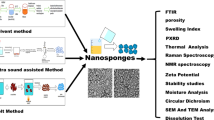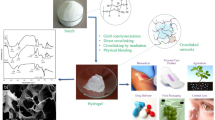Abstract
Purpose. The purpose of this study was to develop novel drug delivery systems with pH-sensitive swelling and drug release properties for localized antibiotic delivery in the stomach.
Methods. The drug delivery systems were synthesized by crosslinking chitosan and poly(ethylene oxide) (PEO) in a blend to form semi-interpenetrating polymer network (semi-IPN). Scanning electron microscopy was used to compare the surface and bulk morphology of the freeze-dried and air-dried chitosan-PEO semi-IPN. The hydrogels were allowed to swell and release the antibiotics—amoxicillin and metronidazole—in enzyme-free simulated gastric fluid (SGF, pH 1.2) and simulated intestinal fluid (SIF, pH 7.2) at 37°C.
Results. Freeze-dried chitosan-PEO semi-IPN with a porous matrix had swollen extensively as compared to the air-dried hydrogel. The swelling ratio of freeze-dried and air-dried chitosan-PEO semi-IPN after 1 h in SGF was 16.1 and 2.30, respectively. More than 65% of the entrapped amoxicillin and 59% of metronidazole were released from the freeze-dried chitosan-PEO semi-IPN after 2 h in SGF.
Conclusions. The results of this study suggest that freeze-dried chitosan-PEO semi-IPN could be useful for localized delivery of antibiotics in the acidic environment of the gastric fluid.
Similar content being viewed by others
REFERENCES
S. S. Davis, J. G. Hardy, and C. G. Wilson (eds.). Drug Delivery to the Gastro-Intestinal Tract. Ellis Horwood, LTD. Chichester, U.K., 1989.
P. K. Gupta and J. R. Robinson. Oral controlled-release delivery. In A. Kydonieus (ed.). Treatise on Controlled Drug Delivery. Marcel Dekker, Inc., New York, N.Y., 1992, pp. 255–313.
H. E. Junginger (ed.). Drug Targeting and Delivery: Concepts in Dosage Form Design. Ellis Horwood, LTD., Chichester, U.K., 1992.
A. Rubinstein and D. R. Friend. Specific delivery to the gastrointestinal tract. In A. J. Domb (ed.). Polymeric Site-Specific Pharmacotherapy. John Wiley & Sons, Chichester, U.K., 1994, pp. 267–313.
A. Ateshkadi, N. P. Lam, and C. A. Johnson. Helicobacter pylori and peptic ulcer disease. Clin. Pharm. 12:34–48 (1993).
J. R. Warren. Unidentified curved bacilli on gastric epithelium in active chronic gastritis. Lancet 1:1273 (1983).
B. J. Marshall. Unidentified curved bacilli on gastric epithelium in active chronic gastritis. Lancet 1:1273–1275 (1983).
D. M. Murray. Clinical relevance of infection by Helicobacter pylori. Clin. Microbiol. Newsletter 15:33–37 (1993).
R. L. Sidebotham and J. H. Baron. Hypothesis: Helicobacter, urease, mucus and gastric ulcer. Lancet 1:193–195 (1990).
L. J. Goodman and J. M. Lisowski. Helicobacter pylori and the upper GI tract: A bug for all lesions. Hosp. Formul. 26:792–800 (1991).
R. A. Siegel, M. Falamarzian, B. A. Firestone, and B. C. Moxley. pH-controlled release from hydrophobic/polyelectrolyte copolymer hydrogels. J. Controlled Rel. 8:179–182 (1988).
M. M. Amiji and V. R. Patel. Chitosan-poly(ethylene oxide) semi-IPN as a pH-sensitive drug delivery system. Polymer Preprints 35:403–404 (1994).
V. R. Patel and M. M. Amiji. pH-sensitive swelling and drug release properties of chitosan-poly(ethylene oxide) semi-interpenetrating polymer network. In R. Ottenbrite, S. Huang, and K. Park (eds.) Hydrogels and Biodegradable Polymers for Bioapplications. ACS Symposium Series Publication. (In press).
T. Chandy and C. P. Sharma. Chitosan—as a biomaterial. Biomat., Art. Cells, Art. Org. 18:1–24 (1990).
S. Hirano, H. Seino, Y. Akiyama, and I. Nonaka. Chitosan: A biocompatible material for oral and intravenous administrations. In C. G. Gebelein and R. L. Dunn (eds.) Progress in Biomedical Polymers. Plenum Press, New York, N.Y., 1990, pp. 283–290.
W. S. W. Shalaby, G. E. Peck, and K. Park. Release of dextromethorphan hydrobromide from freeze-dried enzyme-degradable hydrogels. J. Controlled Rel. 16:355–364 (1991).
The United States Pharmacopeia/National Formulary. Volume XXII. The United States Pharmacopeial Convention, Inc. Rockville, MD. 1990, pp. 1786–1792.
H. Park and K. Park. Hydrogel foams: A new type of fast swelling hydrogels. Trans. Soc. for Biomaterials 17:158 (1994).
K.-D. Yao, T. Peng, H. B. Feng, and Y.-Y. He. Swelling kinetics and release characteristics of crosslinked chitosan-polyether polymer network (sem-IPN) hydrogels. J. Polym. Sci., Part A: Polym. Chem. 32:1213–1223 (1994).
T. Chandy and C. P. Sharma. Chitosan matrix for oral sustained delivery of ampicillin. Biomaterials 14:939–944 (1993).
Author information
Authors and Affiliations
Rights and permissions
About this article
Cite this article
Patel, V.R., Amiji, M.M. Preparation and Characterization of Freeze-dried Chitosan-Poly(Ethylene Oxide) Hydrogels for Site-Specific Antibiotic Delivery in the Stomach. Pharm Res 13, 588–593 (1996). https://doi.org/10.1023/A:1016054306763
Issue Date:
DOI: https://doi.org/10.1023/A:1016054306763




